(Editor’s note: This article was written by Sarah Farver)
A couple of years ago I got my husband a reloading set up for his birthday because I had a feeling it was something he’d really enjoy. Well, he did. So much so, that it turned into how he decompresses each day after work. Before long, he became pretty passionate about it and had learned quite a bit. All I had to do was express an interest and he was all about taking me under his wing.
If you’ve never reloaded before I want to caution you to FOLLOW DIRECTIONS. I realize most of you are men and that goes against the very fiber of which you’re made, but the manufacturers know of what they speak. Heed their advice. They have tested the propellant, the bullets, the casings and such, so just believe that they know what they’re talking about and enjoy success at reloading from the very beginning.
The steps are pretty simple, really. First, save old brass casings, because they aren’t cheap. You’ll be able to use them a few times over, so it’s just the smartest way to roll. Then you will clean them. (You wouldn’t want dirty ammo going in your gun, as it could muck it up.) Next, remove old primers and re-bell the casing, prime the casing, add the correct amount of propellant and then seat the bullet in its case. Then we measure to make sure the end result is the right length. You don’t want it too “tall” or “too short”, as both have bad consequences. All of the tables that are provided with the gunpowder (propellant) give specific amounts and measurements.
There are some things a person learns by listening or reading and other things you pick up along the way. Hopefully the following will help you learn from my mistakes, and save you a little moolah as well.
Go Standard
It’s a good idea to start with a standard re-loader, instead of a progressive one. The one we use is the Rock Chucker Supreme Press. It is pretty simple to use and the start-up costs were not too expensive. What’s more, the handle can be switched to be used by both left and right-handed people. This makes a difference for southpaws like myself.
Save Money with Generic
Generic bullets and casings have worked just fine. You can save a good bit if you shop around the internet and get some generic ones. The brass casings can be reused, but you need to examine them after each use to make sure they aren’t damaged or weakened. Generally, you can reuse a pistol casing 3-5 times. After we have reloaded a box or reused casings, we run a marker over them so we are sure to put sort them correctly after they have been shot.
Start with 9mm
We started with 9 mm because it seemed like an easier than the .45. It may be personal preference, but once we got the feel of it we quickly added other sizes.
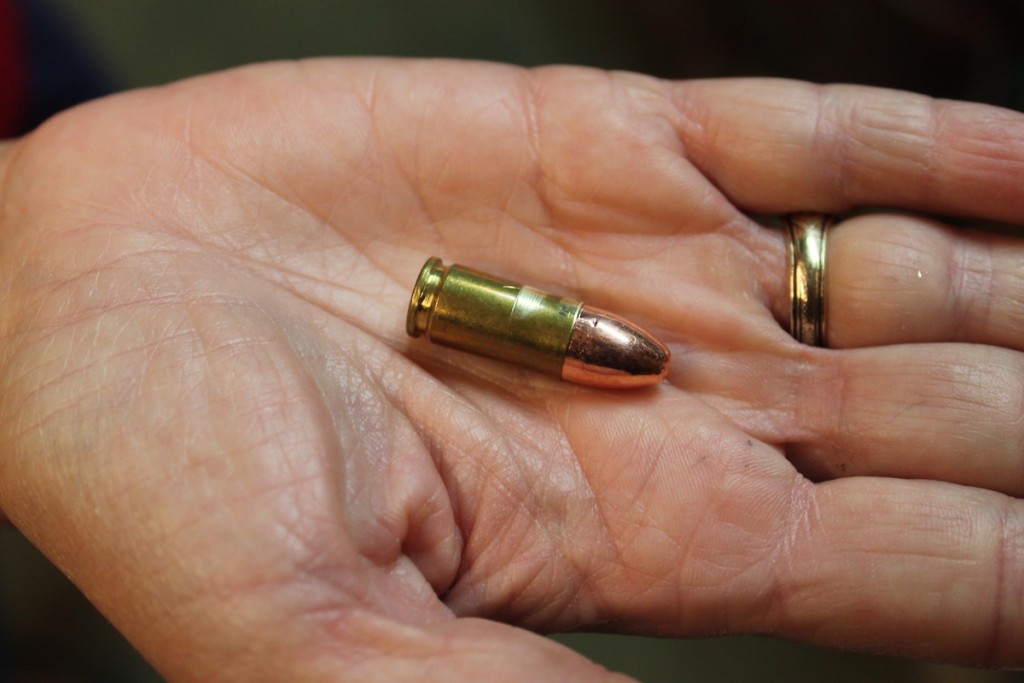
It’s okay to make mistakes. Here the bullet wasn’t properly seated. You can see the “ding” in the side of the casing, so it got trashed.
Check Primer Pocket Size
The primer is a tiny little cup of primer compound and when it is struck by the firing pin it causes the propellant to ignite. Even though it is a wee little thing, it is something that should be stored in a dry, cool place. Of late, we’ve been loading .45 ACP and learned the hard way to check the primer pocket size when you order them. Some manufacturers make .45 ACP with a small pistol primer and some are a bit larger. It will make a difference depending on which casing you have to plug it into, but I assure you that if you try to force the bigger diameter primer into the smaller primer pocket, it can cause a lot of frustration. What’s more, if that little sucker ignites, you might just wet your pants.
Measure!
Measure, measure and re-measure. Before you get started, set up the powder dispenser to whatever the manufacturer’s chart says. Download the chart from that company’s website and refer to it as you get things set up. After that step when you seat your bullet into its spot, measure the total length. Once you’ve done this and fired those bullets and are happy with how they are shooting you won’t need to constantly be measuring. At first it was a little tedious until I got into my groove with it.
Conclusion
Guys, I’d encourage you to take your wives out to the range with you. Make sure she is comfortable with handling a gun and encourage her to practice regularly. Then, gradually introduce her to reloading and you may just find that she enjoys it. If not, she may lie about it just to spend time doing something you enjoy. Either way it’s a win, right?
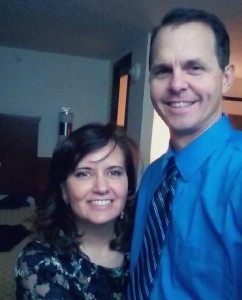
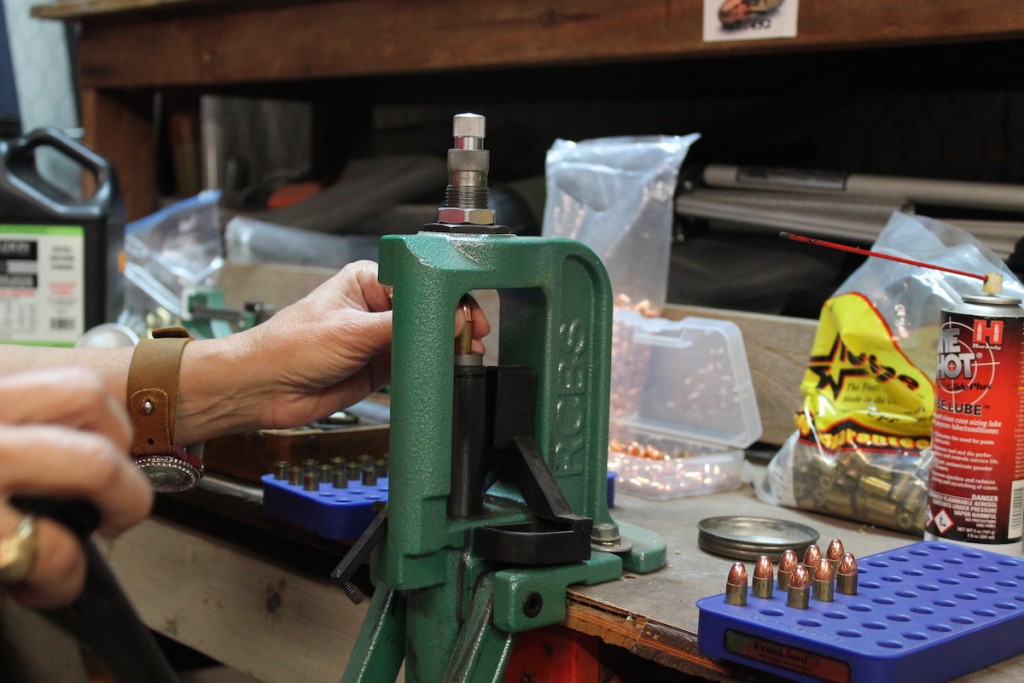
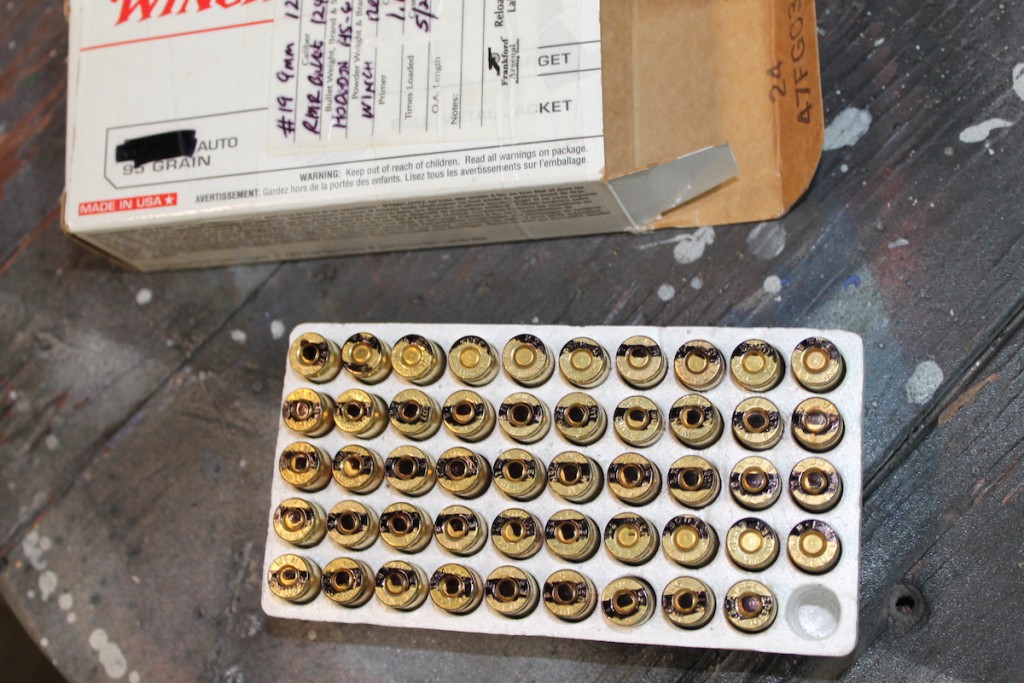
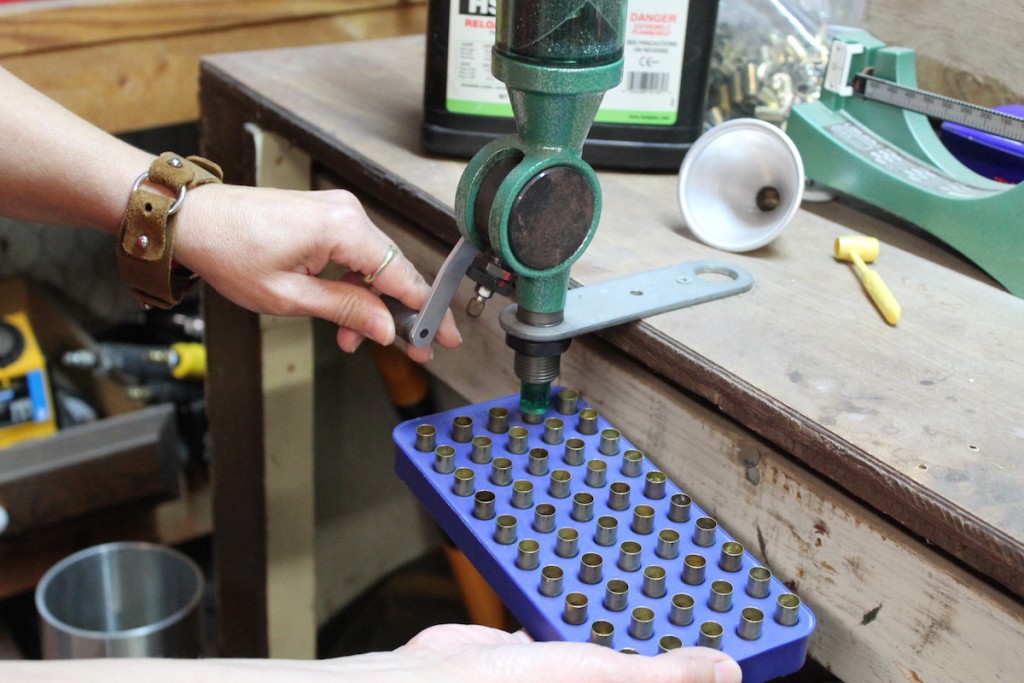
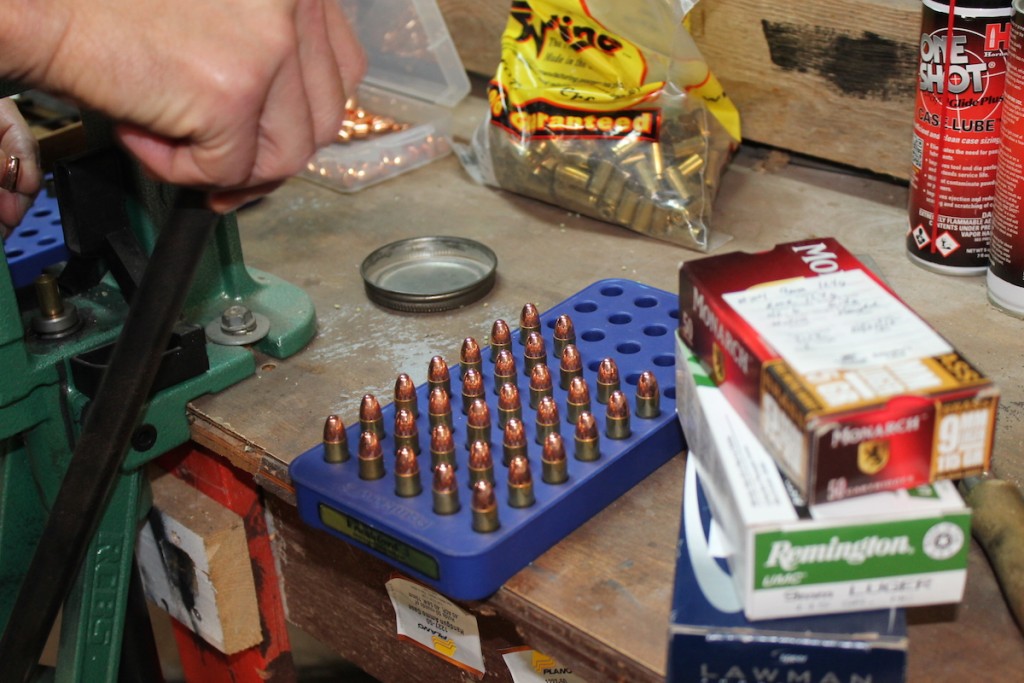
A lot of good suggestions are in the comments. Filtering them out should be the task of an experienced reloader.
“…reuse a pistol casing 3-5 times…”. What!? What is blazes are you shooting!?
Let the brass itself guide you!
– Primer pocket loose? Discard or mark for discard
– Case bulged or cracked severely bent? Discard. Bob above is correct about shallow dents, they will fireform or resize out. Sharp creases and bulges work harden the brass causing cracks. Safer to just discard. Already cracked, discard!
– After multiple resizings, start checking for brass that is too thin. When cutting the brass down you’ll begin to recognize thin brass. Discard.
Quality brass will last a long time! Provided one is sensible about reloading them!
Beginner shooters often start reloading hot loads. Worse, often the hotter the better. Hot loads are bad for brass. frequent hot loads are when people ‘discard’ brass after a few reloadings; without bothering to wait for the inevitable loose primers.
Curious if you are shooting hot? Check your fired cases for flattened or mis-formed primers, (deeper than usual pin dent, primer brass flowing, primer squirting out). Another hint that you are shooting hot is when there are large fireballs when you are shooting. The fireball is unburned powder as excessive powder charges are necessary to ‘overdrive’ the bullet to higher velocities. The highest velocities give the lowest ratio’s of powder to velocity.
Learning to shoot well means expending time and shells learning to aim, breathe, stance or position and squeezing triggers.
Skills that are best learned slow and steady firing efficient low pressure rounds down range.
Use the load tables in cartridge reloading manuals!!
– Select several low pressure rational velocity loads and then check to see if you can obtain the components easily!
Don’t be surprised if powders or other components are not available in your neck of the woods. If you have already formed a strong preference for makes, buy enough to stockpile after you’ve tested loads.
– Make up a range of mild loads, keep explicit notes and keep the loads well identified and separate. Just marking loads with a colored marker and keeping good notes will suffice. Carefully shoot the loads, mark the targets with load info and evaluate later!
– The loads that you and your firearm consistently shoot better are the loads you should select for general practice and high volume loading.
– Use the same methodology for choosing high performance loads. Do not expect that the same powders and bullets will transition from range fodder to high performance loads.
– Pick your and your firearm’s favorite high performance loads and then learn to shoot them well.
If you are experiencing frequent duds, i.e. more than one or two shells in a batch, (I consider one dud too many). Clean up your act!!
The most frequent causes of duds:
– Excess resizer lube is probably the greatest evil. Excess resize lube causes case dents while resizing and any trace of resize lube entering a primer can negate the primer.
– Left over moisture or solvent from any sort of bath. If you are impatient, heat the cases in a 150-200 degree oven till dry.
– blocked primer pockets! Cleaning media, (walnut or corn chips) may stick inside a case and later fall down to block the primer pocket before charging with powder.
– grimy or oily hands may also contaminate primers, so wash those hands! Frequently if necessary!
Several of these contaminants may also affect the powder charge. Any dud that had the primer fire but didn’t fire the powder, or the shell is missing the powder; likely had enough force to plug the barrel with the bullet!
Check the barrel!! Before pulling the trigger again, if a primer popped or the shell is a squib, check that the barrel is clear!!
Never! Never ever reload shells while intoxicated at all! If you drank any alcohol or used any narcotic or mood enhancer, legal or illegal, do not even bother using the reloading equipment.
Even seemingly minor mistakes, wrong powder, components or measurements and small bombs result. What shell result may even work in some overbuilt guns but result in disaster for lighter arms.
Double and triple check everything! If you’re feeling impatient, go do some yoga until you’re calmer. Impatience and reloading is not a good mix.
With a single stage press, I measure every powder charge and then after all of my shells have been charged and moved to the other side of my body, I then use a flashlight and check to see if the charges are all the same level!
On a multi-stage press I still pull the case every few rounds and double check the charge on a scale! Maybe if I was reloading for profit, I would be more chary of time spent checking, but I am reloading for pleasure and I want to keep doing that!
Most of my shooting is for skill at shooting groups. I do not get a kick or any thrill from fast shooting on moving targets or from stations. My competition is with my self and my firearm. Most firearms are capable of greater accuracy than their owners. If not, a little tuning with both the firearm and ammunition will improve the firearm. When my groups open up, I search for reasons why and I am not surprised when the reason is me. Eliminate reasons why your ammunition could be causing less accuracy and then you only worry about the firearm and yourself.
* Choose the equipment you are MOST comfortable with!?
* Many well equipped reloading suppliers will have presses and other equipment mounted. Try them! Remember. that even the biggest store will not have every equipment manufacturer or gear!
* Inquire of friends and people that you shoot with what they like to reload with, and then ask if you can watch.
* Many folks will be glad to share methods and tricks.
* Many people tend to be thoroughly wedded to certain manufacturers and products. be aware of this and try not to let someone else’s prejudice affect your rationale. Nor should you judge their selections and choices!
* Choose gear because You like it!
Reloading manufacturers are competitive! Often a manufacturer may specialize in certain kinds of gear or supplies. Which means that, in most cases, a mix of manufacturers and suppliers are what is best for you.
I started centerfire reloading with a cousin who had a simple hand press best used by hammering. Mostly because of noise, resizing brass by hammer persuasion, I bought a, RCBS rock chucker on sale.
Was my Rock Chucker faster than hand loading? Not really, because we could sit and watch television while performing the mindless actions of decapping, resizing or trimming. yes, I could reload 9mm or .38 special shells on a ratio of 3 to his 1, but he was reloading 44 magnum. When I reloaded .270 Winchester or even .357 mag, the ratio fell to almost even. All other reloading operations took place in my reloading den.
Back then I had come across and old door and I used that for my table. The door turned out to be solid oak and handled the Rock Chucker well. My cousins pounding was far too loud on the table, the floor with yellow pine on true 6″X2″ beams was quieter.
When I moved, the table was discarded, a huge mistake I soon discovered.
After the move, I tried clamping the Chucker to a metal table. Wrong! After a succession of bad choices I went to the hardware store and bought some plywood. Bad choice! Many of the alleged plywood available inn the big box stores have large voids or foam interiors. Pressure crushes the layers.
A true lumber yard will have real plywood, often termed pattern or marine grade.
I went back to the big box store and bought a bunch of two by fours. The top I made of two by fours on edge and then I built a stand for the top tat supported the stress and allowed me to sit anywhere along one side. I mounted an oak plank from an old drawer from a sidewalk pile of trash; hint, many old drawers have hardwood sides. This plank was where I planned to put the Rock Chucker as it would take surface issues and stresses better than cheap 2X4s do.
Placing the Chucker on the plank. I marked the holes and I noticed that the down stroke of the Chucker knocked against the bench. Marking the area with a pencil, I chiseled out the area till the piston fit; drilled bolt holes and mounted firmly.
From my original lapidary stone scale I’ve upgraded through several balance beams and even picked up a Mettler scale, a laboratory 4 decimal place scale, for a few dollars plus a promise to not bring it back. I haven’t bought a digital scale yet, mostly because I don’t need it and I’d rather buy other things with spare cash.
Initially I started reloading with a MEC progressive shotshell reloader. Back then I used far more shotgun shells hunting pheasants, grouse, doves, squirrels and rabbits than I shot centerfire rifles and pistols. A few years ago, I picked up a Hornady progressive reloader that I do like.
Old habits die hard though and since most of my shooting is focused on small groups, I still proceed at a very slow pace.
Useful extras:
`A turning station for cutting cases back. Much easier or faster than a bastard file for most people.
`A counter sink and outer case neck turner for removing burrs. Professionally, machining gear is available that is functionally better, but also more expensive.
`A primer pocket brush.
` Some diamond files, especially a flat and a half round.
` Many people like shiny brass and it is good for your equipment. Having a lapidary background, I opted for a lapidary quality Gy-Roc vibratory tumbler. They’re made for heavy loads over long periods of time. Any lapidary tumbler will suffice, the vibratory ones are just quicker. The better lapidary tumblers are expensive, but burn through a couple of cheap tumblers and you’ve reached the price of the lapidary ones.
` Choices of tumbling media is just one of those personal choices. Though different abrasive powders are preferable. Some, e.g. rouge (iron rust), stain; worse, rouge spreads almost endlessly and stains. Opt for cerium oxide, tin oxide, micro-alumna oxide or white Tripoli. Turbo-brite is a brass chemical polish meant for adding to media and works well. As I buy other lapidary supplies from lapidary dealers, I may or may not order consumables from them. After adding shipping costs, walnut or corncob media prices at your local store are darn good.
The author Sarah Farver shows us a 9mm shell and insinuates that it is not shootable. Sadly, that is untrue as a number of others point out.
What affects shootability or accuracy:
* marks on the sides of and usually on the front of bullets minimally affect shootability or accuracy. A major dent on the front of a bullet will likely affect reliable shell feeding and may slightly alter accuracy.
* Marks on the base or especially the bottom edges of a bullet will affect accuracy!
* Scratches or minor dents on the side of the case might affect chambering, but neither will affect shootability or accuracy, unless the dent affected the powder capacity and there is a reduced powder charge.
* Appearance does not determine shootability nor accuracy!
* Sharp angled dents are a problem. A sharp crease in brass is where a crack will form. Dispose of creased cases.
* Use a decent bullet puller to remove bullets and powder. Personally, I dispose of the powder too as multiple handlings increases the chance of contamination and I am slow enough. But carefully remeasured the powder is still usable. Unless mangled, the bullet is still usable. One can still use a firearm to pop the primer so long as the case is not mis-shaped too badly.
* Let the brass be your guide for when to discard it!!
Military sourced ammunition requires special handling for reloading!
Some discount ammunition makers are actually reloaders and source their fired brass almost anywhere. Be care and exercise due diligence when using highly discounted brass.
My shelves have multiple brands of equipment, powder, bullets and accessories. Eventually, so will yours.
Excellent info. I am just getting started.
I have been reloading for over 40 years and started with an RCBS Rock Chucker basic package with a single stage press.
I added a separate Primer Tool that is bench mounted and also a power case trimmer for rifle cases. I shoot a lot of pistol ammo and yet I have stuck with the same single stage press for all of these years as I think the progressive presses are too complicated for me. Use Carbide dies and get the Case Gauges like the Wilson series for ALL of the calibers that you shoot. When the finished reloaded round fits inside the gauge, it will NOT cause an issue feeding on the range.
I’ve been reloading since 1990. I broke my Lee single stage, and moved up to a Rock Chucker as well. What a difference! Quality products make for more fun. I started when stationed in Maine, and long, cold winters allowed for plenty of time to reload a lot, even with the single stage. I keep thinking about a Dillon progressive, but the whole “Zen Vibe” I get with my single stage would be missed. But now I’m in CA, and the winters are so mild I shoot all winter long, and need the speed. Christmas is coming soon, so maybe Santa will bring me a Dillon…(Honey? Are you listening?)
Sorry but I do disagree with start with 9mm. I started with .45 because thats my primary load for everything! And got it set and rolling in a jiffy!
Good book if you are a .45 nut! Big Fat Book of .45 ACP! Talks about how easy the cartridge is to reload!
Great article and glad to see women getting involved in all aspects of gun/shooting not just targets at the range! Keep spreading the good word!
This is in response to “Judy’s” request to recommend a progressive press or two. The best basic for your money, in my opinion, would be Dillons Square Deal B. This is a very basic reloader that now can be upgraded with additional features. I personally went to the Dillon 650 with all the bells and whistles for several reasons. It has a case feeder, powder check for both your loaded round and the power hopper and a reminder system of low primer feed before you run out. It also is capable of producing up to 800 rounds of pistol ammo per hour, and with the amount of shooting I do this is a tremendous feature. Lastly, Dillon has a no B.S. warranty for all their presses as well as a staff ready to answer any of your questions via email or phone. Good luck and safe shooting. Badgerman
Get a good basic chronometer and measure the muzzle velocity of your loads.
Overlooking some important standards is a disturbing trend among too many “how-to s” I have read over the years.
Check weights for verifying scales is almost universally left out of articles and books about reloading.
This is especially important if you gravitate toward the less expensive versions of digital scales routinely offered.
Beginning reloaders should look for and use powders that are most likely to fill the majority of space available in the case/caliber you are loading. Denser / more powerful powders may be more economical in the long run, but the possibility of over -or- double charges along with the possibility of bullet setback has proven disasterous for many neophyte reloaders.
Checking finished loads with gages (or at least in the barrel’s chamber ) will help to eliminate mistakes also.
Hand operated priming tools have the ability to make that aspect of case prep much safer due to more handling/inspection of the casings and a much better “feel” for the insertion fit of the primers to the case well.
These are just a few things that are often omitted in many well meaning how-to s.
Not a bad article, but some inaccuracies and glaring mistakes. There is no such thing as “Generic” brass, all has a name on it. There is fired brass or new brass, that may have been the point. The powder dispenser is mounted too close to the bench and too low, there is no way you could charge the center row of brass. Checking the primer pocket size is a moot point. If you have military brass, you have to swage it for the first reload. Commercial brass is loose or not, and I have found some loose ones during priming, maybe 2 or 3 out of 100. I simply mark them with a black marker across the base for discard after firing. Not trying to be overly critical, just pointing a few errors out. Happiness is reloading.
Then again you may not ever need a progressive loader. Started loading in 1968 with a simple c-press, have 2 Rock Chuckers set up now and one $20.00 Lee I just use for bullet seating. I load because I “like too”, not because it may be cheaper, more accurate etc. I found a long time ago that when I shut my reloading room door any stress I had vanished, worries of the world slip away, etc. because you have to concentrate on “loading”. I load at least 8 rifle calibers for sons and grand daughter, I shoot GSSF and SASS, and can load, in a couple hours, enough for 5 stages of SASS. Mostly load .45 acp and .45 Colt. If I need more bulk ammo for a course of some nature, ie Shootrite Academy etc…. I use TargetSport and buy by the case. I have access to a fully loaded Dillon 650, and have yet to pick it up. May have to one day if the grandkids start shooting more. Other wise I’ll load one at a time and cast many of my own bullets, just because I like too…… You may also…
Step number 1 should be safety. Make sure to have safety glasses on. Also, I want to point out that a little dent in a case is not a reason to throw it away. Shooting the round will fire form it, making it just right again. Also, I would say start not with 9mm but with your most expensive caliber or what you shoot the most. I get more sense of accomplishment when I load .308 than I do large batches of .40. Probably not going to reload much 9mm, as ammo is cheap. And don’t bother with a single stage, get a turret press. You can use it as a single or as a turret. Give your self options and future proof. Of all the reloading, the most fun for me is shotshell.
KISS. Always follow your reloading manual. Start with one caliber, one powder, one primer, one bullet, one brand of once fired or new case. Once you add other calibers and or loads, clear off your reloading area and put everything away before starting with another caliber or load. This will prevent a potentially very costly mistake and not just with material things. Reloading errors have cost people the loss of life and limb.
Some really good points on all of these comments. I won’t even try to sound like an expert, just tell you what I did for the last 30+ years. I started out 60 years ago watching my Dad reload rifle only (for some reason Dad never liked hand guns). Over the years he would eventually let me sit down and learn and do it myself with him watching over and then got to the point where he would say hay we need a couple boxes of 270 and I would spend the weekend in the basement. Dad got to the point where he couldn’t go out in the field anymore and gave me all the reloading equipment that consisted of a herters single stage, case trimer, scale and some odds and ends and you would have thought I was I was in heaven. This was all good until about 5 years ago when I got the bug to buy a handgun, witch turned out to be an obsession (15 and counting). As it turns out I shoot a LOT more handgun rounds than rifle rounds in a given month go figure. So my little single stage witch I was really good at was not able to keep up with my demand. I did my research and thought I had a clue and really didn’t and bought a progressive. I have had it for about a year now and other than spending close to $600 and still not having everything I need to make all the necessary caliber switches yet it is a blast and I love it. Learning curve was/is steep but its ok I’m retired and I have the time. Sorry for writing so much but like I said I’m retired and I have the time.
I’ve been reloading since 1965 and for the most part the information is good. One point that I strongly disagree with is the use of generic brass. Armscor brass has horrible quality control such as the inability to hold the bullet firmly in the sized case and severely off center primer holes, which break your decapper pin. Stick with name brand brass and save yourself some money and aggrevation
Before charging cases with powder, I also throw a couple charges and weigh them, especially if using a new batch of powder. After charging the cases with powder, take a minute and physically check the powder in the cases. Run your eye up and down the rows. Any powder levels that are too low or too high will quickly show up.
I find 45ACP to the most problematic that I reload. There are so many bad ones that I find it to be a waste of money for just target practice loads. I still reload them for hot rounds , etc. I attribute this to the fact that the ejection process really gives these rounds a beating in many guns bouncing them off of walls and onto concrete floors. Plus I shoot some full auto open bolt guns. The best to start with in my opinion is .38/.375. But this round will give you a serious introduction to the use of “case lube” if you are reloading magnums and “+P”s
I find 45ACP to the most problematic that I reload. There are so many bad ones that I find it to be a waste of money for just target practice loads. I still reload them for hot rounds , etc. I attribute this to the fact that the ejection process really gives these rounds a beating in many guns bouncing them off of walls and onto concrete floors. Plus I shoot some full auto open bolt guns. The best to start with in my opinion is .38/.375. But this round will give you a serious introduction to the use of “case lube” if you are reloading magnums and “+P”s
“First, if you plan on shooting a lot, get a quality, BASIC progressive reloading press…”
Can you recommend one or two, please?
Thanks! 🙂
I have to agree with the writer. Start out with a single stage and move up to a progressive after you figure out what you are doing. As to RIFLE bullet reloading, all my rifle bullets are reloaded on a single stage press. I fell one has more control and can load more accurately on a single stage. As to single state presses, the one the write is using is a very strong and well made press. I used a older RCBS press for several years. For the money their presses are hard to beat. I recently bought a Forester Coax press. I like it as it requires no shell holders but most of all it makes very accurate ammo with little physical effort but does cost much more than the Rock Chucker. But the Rock Chucker has been around many years so there are used one’s out there to be had for a low start up cost and they are so heavy duty they should last a couple of lifetimes. I kept my old RCBS even after buying a new press as it still has it uses.
As to handgun ammo, it’s generally shot up more quickly so you would probably eventually want to go to a Turret or progressive. I feel a Turret press gives one more control and is nearly as fast as a progressive.
Personally I feel one has to be extra careful reloading handgun ammo as the charges of powder are so small that it’s easy to double load the case which could cause damage to the weapon or yourself. One thing nearly as bad is to load a round without powder. If this happens the primer often has enough power to send the bullet out of the case into the barrel but not out the barrel. So if you ever hear just a snap, Don’t load that next round into the chamber and try to fire as only bad things can happen. Clear your weapon and verify there is no round stuck in the barrel.
I didn’t see any mention of “plunk test”, which is essential when loading semi auto ammo.
While I applaud your efforts to help your husband, and I agree that reloading is a wonderful pastime, I disagree with several points. First, if you plan on shooting a lot, get a quality, BASIC progressive reloading press (not one with a bunch of bells, whistles and Rube Goldberg linkages.) I’ve observed many new reloaders quickly tire of the excessive number of strokes necessary on a single stage. Personally, I began with a progressive over 30 years ago and I’m still using the same press. Buy quality. Second, for beginners, get quality components, especially do not get unknown, el-cheapo bullets. It will eliminate one of the variables in the process. Cheap bullets may or may not be sized correctly and if improperly manufactured will lead to very poor accuracy, and again, frustration. Once you are familiar with the reloading process and results, then start looking for less expensive bullets. Third, the 9mm can be a tricky round to begin with as the case volume is small, the pressures are high and it is less tolerant of mistakes. 45ACP and/or .357 Mag (loaded to target velocities) are better choices. Both will be more tolerant of variations in the loading process than the 9mm. Fourth, get several up to date loading manuals. READ THEM. Fifth, if reloading for rifle, get a case gauge to ensure you are making properly sized cartridges. I guarantee you’ll thank me. Six through ten, have fun.
“First, if you plan on shooting a lot, get a quality, BASIC progressive reloading press…”
Can you recommend one, please?
Thanks! 🙂
A Lee Pro 1000 is the least expensive,(about $175 online) and usually comes with the caliber of your choosing. Be aware some mechanical ability is VERY helpful when getting started, with any progressive unit. It is very good idea to start with a single stage first, to get the idea and feel of what is happening in each step.
Buy a Dillon Press.
Another note that has been drilled into me will be when handling primers wear dry nitrile or latex gloves, if you touch anything moist including yourself with them replace the gloves. Primers are sensitive to moisture so if any gets in them from handling it will decrease the chance of it going off even more. Someone I know that has been reloading for awhile now learned that early on when 1 out of 10 rounds would go off fully, some were duds, and some would be not as potent and land short of target.
Great article. Just wanted to point out that caption on the second photo says, “A ‘Ron’ Chucker Supreme Press.” I’m only pointing it out because it’s a proper noun and it just looks downright weird. Again, thanks for the article. Feel free to delete this comment…
When you know him as well as we do, you can call him “Ron.” LOL. Good catch!
#6. Dont toss live oops rounds in the trash. Buy a kinetic bullet puller. They are pretty cheap. Simply put the correct collar on, insert round, tighten the cap and strike it like a hammer. Bullet, powder and case are seperated but contained inside. Reuse whats salvageable.